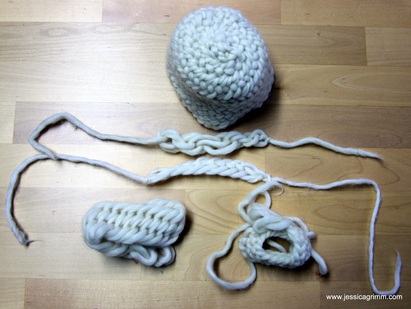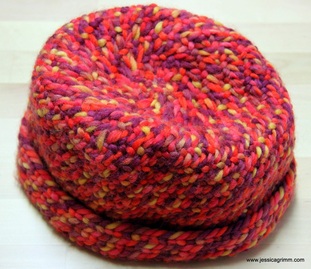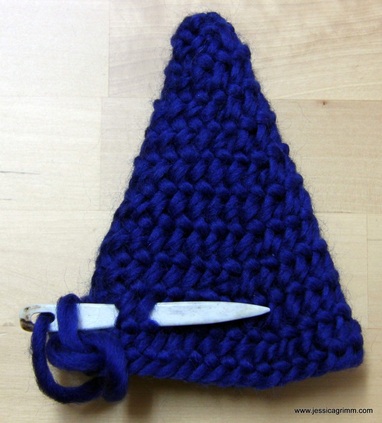|
Since I spent all of last week analysing medieval animal bone from Middelburg, Netherlands, my hands are quite raw and unsuitable for stitching. However, not only was I rewarded with a lot of interesting butchery waste, the material also contained several bone skates, an awl, two combs and a flute. I'll happily nurse my hands back to good health with lots of nice hand creme in the next couple of days. In the meantime, I'll work on my needle binding skills. Needle binding is not some form of Uri Geller magic with sewing needles. It is one of the oldest techniques to produce textile from fibre. As an archaeologist, I had known about needle binding (or Nadelbinden in German and naaldbinden in Dutch) for a long time. On medieval fairs, you often see women producing mittens, socks and hats with wool and a large bone or antler needle. Comparable needles are known in the archaeological record since about 30.000 years ago. Since these needles could have been used for other sewing duties as well, it is hard to say if needle binding is as old. The earliest pieces of needle binding so far found, come from the cave Nahal Hemar in Israel and are almost 10.000 years old. The Neolithic had already started in this area and thus these people were making pots, cultivating crops and keeping animals. Nearer to home, fishing nets found in Friesack (Germany) and Tybrind Vig (Denmark) and date to the Mesolithic Ertebölle Culture (due to the Neolithic starting much earlier in the Levant than in Northern Europe, these Mesolithic finds are actually a bit younger than the Neolithic Israeli finds). From the Iron Age onwards, there are a whole host of needle binding pieces preserved from all over the world. Especially the wet conditions of Northern Europe are favourable to the preservation of textiles. As needle binding produces a fabric that is built up like the coiled shell of a snail, it is usually mittens, socks, hats or nets that are found. So what do modern people need to replicate this ancient technique that is so different from modern knitting or crochet? First of all: good instructions! Go find yourself a nice teacher who shows you the basics. I attended a two evening course with teacher Barbara Samuel at ArtTextil in Dachau, Germany. She was the best! Second: obtain a nice bone or antler needle. They are around €15-20 and well worth the money. Preferably, go and see your needle before you buy. As these are large pieces of equipment and none two are the same, it is important that you and your needle bond :). Added bonus of attending a course: needles to try out. Thirdly, get yourself the book 'Nadelbinden was ist denn das?' by Ulrike Claßen-Büttner. This book is a real gem! It not only explains the technique in a technical textile classification way (important for textile geeks like me), it also has very good step by step instructions and pictures on how to produce the different stitches. And it has a detailed finds catalogue, beginner's projects, advanced ideas and a small picture gallery of modern ideas. If you click on her name you are transported to her very informative website in needle binding. Oh, and yes, you need thick pure wool that felts well. But, the whole needle binding thing comes with a huge health and safety warning.... It is super addictive. Especially for those people who do not particularly bond well with any hobbies that involve either two needles or a nasty little hook. It is indeed very appealing to those of us who like their needles with an eye. As you can see in the pictures above, after my first evening in class and several trial pieces, I needled myself a colourful round hat. Since my hands are still too rough for stitching, I am now needeling a tapered blue version for my husband. Next winter, he will be the tallest living dwarf on earth :). And after that, it is on to needling mittens. And then the Queen of projects: socks.
What do you think? Did you know about the technique and would you like to try it? Please leave your comments below!
3 Comments
|
Want to keep up with my embroidery adventures? Sign up for my weekly Newsletter to get notified of new blogs, courses and workshops!
Liked my blog? Please consider making a donation or becoming a Patron so that I can keep up the good work and my blog ad-free!
Categories
All
Archives
July 2024
|
Contact: info(at)jessicagrimm.com
Copyright Dr Jessica M. Grimm - Mandlweg 3, 82488 Ettal, Deutschland - +49(0)8822 2782219 (Monday, Tuesday, Friday & Saturday 9.00-17.00 CET)
Impressum - Legal Notice - Datenschutzerklärung - Privacy Policy - Webshop ABG - Widerrufsrecht - Disclaimer
Copyright Dr Jessica M. Grimm - Mandlweg 3, 82488 Ettal, Deutschland - +49(0)8822 2782219 (Monday, Tuesday, Friday & Saturday 9.00-17.00 CET)
Impressum - Legal Notice - Datenschutzerklärung - Privacy Policy - Webshop ABG - Widerrufsrecht - Disclaimer









 RSS Feed
RSS Feed